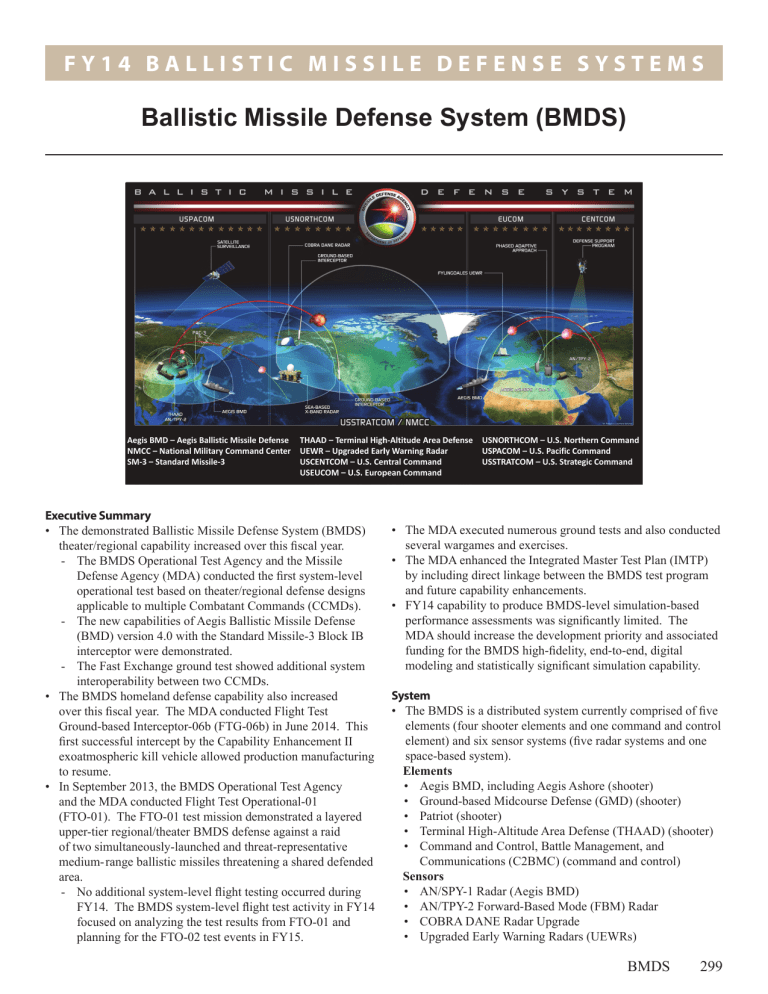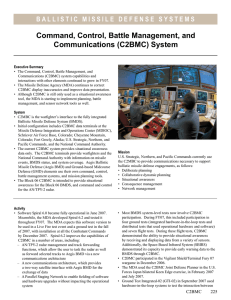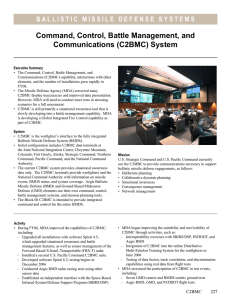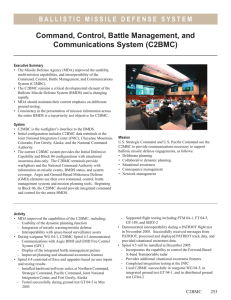Ballistic Missile Defense System (BMDS)

F Y 1 4 B A L L I S T I C M I S S I L E D E F E N S E S Y S T E M S
Ballistic Missile Defense System (BMDS)
executive summary
• The demonstrated Ballistic Missile Defense System (BMDS) theater/regional capability increased over this fiscal year.
- The BMDS Operational Test Agency and the Missile
Defense Agency (MDA) conducted the first system-level operational test based on theater/regional defense designs applicable to multiple Combatant Commands (CCMDs).
- The new capabilities of Aegis Ballistic Missile Defense
(BMD) version 4.0 with the Standard Missile-3 Block IB interceptor were demonstrated.
- The Fast Exchange ground test showed additional system interoperability between two CCMDs.
• The BMDS homeland defense capability also increased over this fiscal year. The MDA conducted Flight Test
Ground-based Interceptor-06b (FTG-06b) in June 2014. This first successful intercept by the Capability Enhancement II exoatmospheric kill vehicle allowed production manufacturing to resume.
• In September 2013, the BMDS Operational Test Agency and the MDA conducted Flight Test Operational-01
(FTO-01). The FTO-01 test mission demonstrated a layered upper-tier regional/theater BMDS defense against a raid of two simultaneously-launched and threat-representative mediumrange ballistic missiles threatening a shared defended area.
- No additional system-level flight testing occurred during
FY14. The BMDS system-level flight test activity in FY14 focused on analyzing the test results from FTO-01 and planning for the FTO-02 test events in FY15.
• The MDA executed numerous ground tests and also conducted several wargames and exercises.
• The MDA enhanced the Integrated Master Test Plan (IMTP) by including direct linkage between the BMDS test program and future capability enhancements.
• FY14 capability to produce BMDS-level simulation-based performance assessments was significantly limited. The
MDA should increase the development priority and associated funding for the BMDS high-fidelity, end-to-end, digital modeling and statistically significant simulation capability.
system
• The BMDS is a distributed system currently comprised of five elements (four shooter elements and one command and control element) and six sensor systems (five radar systems and one space-based system).
Elements
• Aegis BMD, including Aegis Ashore (shooter)
• Ground-based Midcourse Defense (GMD) (shooter)
• Patriot (shooter)
• Terminal High-Altitude Area Defense (THAAD) (shooter)
• Command and Control, Battle Management, and
Communications (C2BMC) (command and control)
Sensors
• AN/SPY-1 Radar (Aegis BMD)
• AN/TPY-2 Forward-Based Mode (FBM) Radar
• COBRA DANE Radar Upgrade
• Upgraded Early Warning Radars (UEWRs)
BMDS 299
F Y 1 4 B A L L I S T I C M I S S I L E D E F E N S E S Y S T E M S
• Sea-Based X-band (SBX) Radar
• Space-Based Infrared System/Defense Support Program
(SBIRS/DSP) mission
• The U.S. Strategic Command (USSTRATCOM) synchronizes operational-level global missile defense planning and operations support for the DOD.
• U.S. Northern Command (USNORTHCOM), U.S. Pacific
Command (USPACOM), U.S. European Command
(USEUCOM), and U.S. Central Command (USCENTCOM) employ the assets of the BMDS to defend U.S. territory, deployed forces, and allies against ballistic missile threats of all ranges.
• USSTRATCOM, USNORTHCOM, USEUCOM,
USCENTCOM, and USPACOM use the C2BMC element of the BMDS to maintain situational awareness. USEUCOM,
USCENTCOM, and USPACOM also use the C2BMC to provide sensor management of theater AN/TPY-2 (FBM) radars.
• Combatant Commanders employ Patriot to provide theater defense for deployed forces against short- and medium-range threats. major contractors
• The Boeing Company
- BMDS and GMD Integration – Huntsville, Alabama
• Lockheed Martin Corporation
- Aegis BMD, Aegis Ashore, and AN/SPY-1
Radar – Moorestown, New Jersey
- C2BMC – Gaithersburg, Maryland
- SBIRS – Sunnyvale, California
- THAAD Weapon System and Patriot
Interceptors – Dallas, Texas
- THAAD Interceptors – Troy, Alabama
• Northrop Grumman Corporation
- DSP – Redondo Beach, California
- GMD Fire Control and
Communications – Huntsville, Alabama
• Orbital Sciences Corporation
- GMD Booster Vehicles – Chandler, Arizona
• Raytheon Company
- GMD Exoatmospheric Kill Vehicle and Standard Missile-3
Interceptors – Tucson, Arizona
- Patriot, AN/TPY-2 Radar, Cobra Dane Radar, SBX
Radar, and UEWRs/EWRs – Tewksbury, Massachusetts activity
• The BMDS Operational Test Agency and the MDA conducted the first operational system-level flight test (FTO-01) in
September 2013.
- The FTO-01 test mission demonstrated a layered uppertier regional/theater BMDS defense against a raid of two simultaneously-launched and threat-representative medium-range ballistic missiles threatening a shared defended area.
- No additional system-level flight testing occurred during FY14, which was in accordance with the
DOT&E-approved IMTP.
- The next system-level operational flight test, FTO-02, is scheduled for FY15.
- The BMDS system-level flight test activity in FY14 focused on analyzing the test results from FTO-01 and planning for the FTO-02 test events.
• The MDA conducted FTG-06b in June 2014. FTG-06b was a system-level flight test of the BMDS Homeland Defense capability.
• During FY14, the MDA executed four major ground tests, including examining cross-CCMD sharing of sensor data in its Fast Exchange test. The MDA also conducted several wargames and exercises.
assessment
• The FTO-01 test mission demonstrated a layered theater/ regional upper-tier ballistic missile defense using a
BMDS instantiation consisting of the Aegis BMD, THAAD,
300 BMDS
C2BMC, AN/TPY-2 (FBM), and SBIRS/DSP elements. The classified DOT&E February 2014 BMDS Annual Report,
Appendix E, assesses the results from this mission and includes six key findings covering system-level performance, effectiveness, and suitability.
- Although a layered defense was demonstrated in FTO-01, true system integration was not demonstrated due to system network configuration errors, interoperability limitations, and component failures.
• The BMDS theater/regional capability increased over this fiscal year.
- FTO-01 demonstrated an operationally representative scenario based on five theater/regional defense designs applicable to USPACOM, USEUCOM, and
USCENTCOM.
- Aegis BMD version 4.0, together with the SM-3 Block IB interceptor, brings new capabilities to theater/regional engagements that successfully completed operational testing. Details of this testing and the Aegis BMD/SM-3
Block IB assessment are reported in the individual article on Aegis BMD later in this section.
- The Fast Exchange ground test showed additional system interoperability between USEUCOM and USCENTCOM areas of responsibility. System-level ground testing is reported in the individual article on C2BMC later in this section.
• The BMDS homeland defense capability increased over this fiscal year. The first successful intercept by the
F Y 1 4 B A L L I S T I C M I S S I L E D E F E N S E S Y S T E M S
Capability Enhancement II exoatmospheric kill vehicle allowed production manufacturing to resume. The FTG-06b assessment is reported in the individual article on GMD later in this section.
• The MDA, in collaboration with DOT&E, updated the
FY13 version of the IMTP to incorporate BMDS element maturity, program modifications, and fiscal constraints. They also enhanced the IMTP by including direct linkage between the BMDS test program and future capability enhancements as defined by the BMDS Phased Implementation Plan.
• FY14 capability to produce BMDS-level performance assessments was significantly limited. The MDA is developing a new high-fidelity, end-to-end, digital performance assessment modeling and simulation capability for the BMDS.
This effort began in FY12 and is currently in the requirements definition phase. Requirements definition is funded through
FY15. In addition, three Small Business Innovative Research contracts were awarded in FY14 to explore a simulation capability to produce statistically significant run sets. The
MDA will assess future funding needs for the implementation of the final design requirements as these initiatives proceed through the remainder of the development program.
recommendations
• Status of Previous Recommendations. The MDA has addressed previous system-level recommendations.
• FY14 Recommendations. The MDA should:
1. Address recommendations made in the DOT&E FTO-01 assessment found in the classified DOT&E February 2014
BMDS Annual Report, Appendix E.
2. Increase the development priority and associated funding for the BMDS simulation-based performance assessment capability, as the ability to produce high-fidelity and statistically significant BMDS-level performance assessments is critical.
BMDS 301
F Y 1 4 B A L L I S T I C M I S S I L E D E F E N S E S Y S T E M S
302




